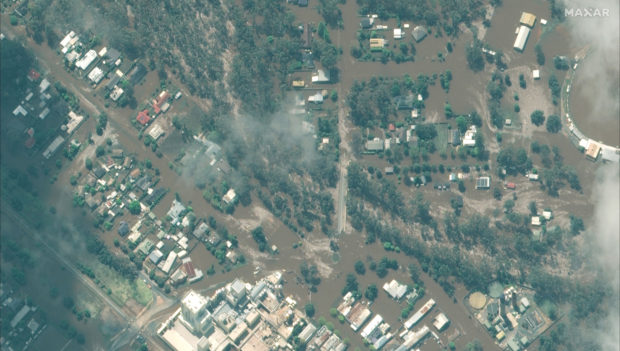Floods isolate Australian wheatbelt towns; Singapore joins rescue efforts

FILE PHOTO: A satellite image shows a flooded Rochester, Australia, October 16, 2022. Maxar Technologies/Handout via REUTERS.
SYDNEY — Hundreds of properties in Australia’s southeast, scrubbed and cleaned two weeks ago after major flooding, were inundated again on Thursday as officials issued fresh evacuation orders while Singaporean rescue specialists arrived to aid relief efforts.
Rural towns in the southwest of New South Wales (NSW) state are the worst hit in the latest deluge after heavy rains over three days through Monday unmoored houses and submerged roads and bridges, turning entire towns into islands.
In Forbes, a rural town of about 8,000 residents in the state’s wheatbelt, the Lachlan river has flooded the main streets and people were being rescued in boats, television footage showed.
“This flood caught people by surprise… The (speed) of water coming through is unbelievable,” said Jeff Nicholson, who manages the Forbes bowling club and has lived in the town for 64 years, told Reuters by phone. “This one here now is a one in a one-hundred-year flood.”
Officials predicted the Lachlan river would peak soon at a 70-year high of just under 11 meters (36 ft) for the second time in as many weeks.
Article continues after this advertisement“We only just finished the damage assessment and the clean-up here. Two weeks later, we’re back into major floods,” NSW emergency services’ Chief Superintendent Ashley Sullivan told ABC television from Forbes.
Article continues after this advertisementFurther west, residents in parts of Condobolin, with a population of around 3,000, have been ordered to evacuate.
To help with relief efforts, 18 flood rescue specialists from Singapore reached Sydney on Thursday, authorities said, who will join a team from New Zealand and hundreds of Australian defense personnel already deployed to the worst-hit regions.
Help has also been sought from the United States for the relief operation, which authorities have flagged will be the biggest flood rescue exercise in New South Wales’ history.
The damage from the latest flood could cost “billions of dollars”, Emergency Management Minister Murray Watt said.
“The bill is really racking up and that’s before we look at the immense cost of road and infrastructure repairs which lies ahead,” Watt told ABC radio. “The worst thing is that this isn’t over yet.”
RELATED STORIES
Australia’s southeast remains on flood watch as river levels peak
Australians rescued from rooftops as torrential rain ravages rural towns